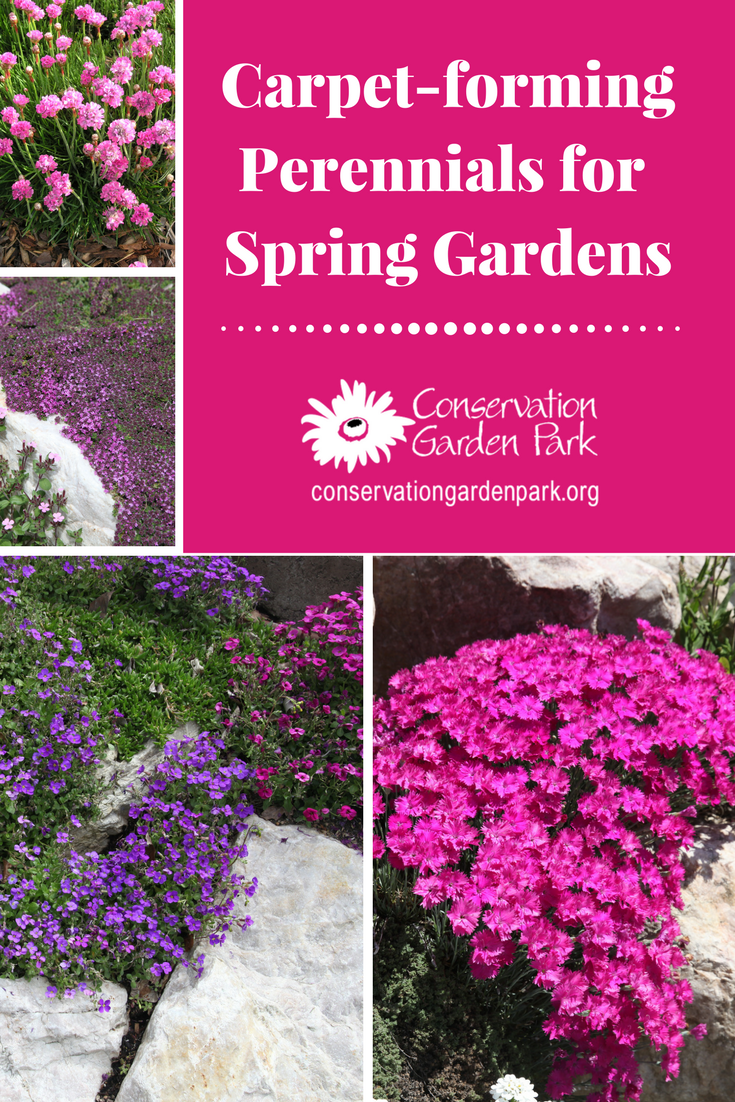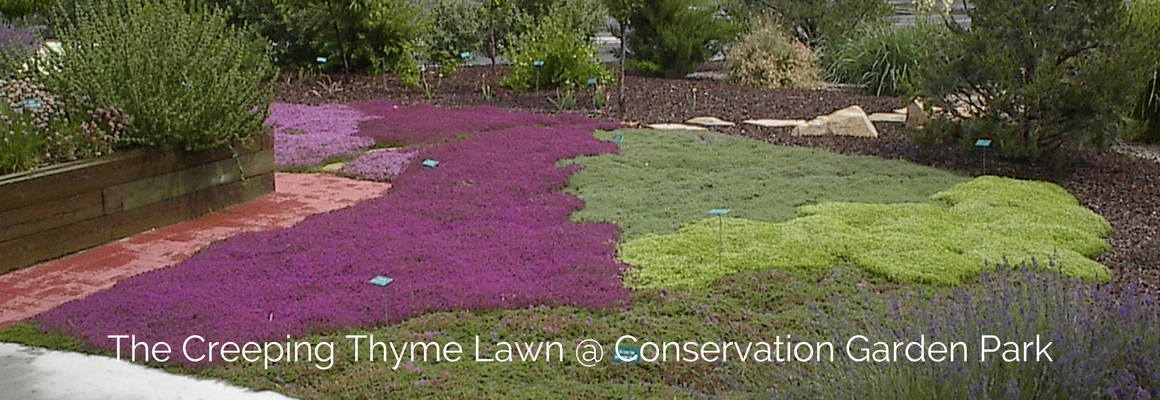
Carpet Forming Perennials for Spring Gardens
-
Spring is in full force at long last! If you look around, you’ll notice many beautiful profusely blooming perennials carpeting local landscapes. For the purposes of this post, we’ll look exclusively at the low-growing, mounded perennials that are profusely covered in blooms and whose foliage forms a carpeting mass. There are plenty of other great spring blooming plants to review as well but that is another post for another day!

-

-
Creeping Phlox (Phlox subdulata)
The Phlox family contains lots of great perennials (and some annual flowers too) that are worthy of the garden. Creeping Phlox is the low growing version with evergreen foliage—did you know there is such a thing as evergreen perennials? Creeping Phlox begins blooming in early spring (usually around the beginning of April in the Salt Lake Valley) and comes in a number of colors and cultivars. As a moderate water perennial, it will need once per week watering.Best Pick: My favorite Creeping Phlox would have to be the magenta/red cultivars such as ‘Red Wing’ that offer a strong hit of unique color and contrast beautifully with many shades of tulips. In fact, it’s a great idea to plant spring bulbs beneath Creeping Phlox.Advantages: Evergreen foliage, masses of vibrant colorsDisadvantage: After the bloom, the foliage can look a little ragged. Clipping back the shaggy foliage will clear up the problem and may encourage rebloom later in the season. -

-
Rockcress (Aubrieta and Arabis)
Aubrieta and Arabis are two different plant groups that share the common name of Rockcress- both have a similar look in the landscape. Arabis is the less commonly available of the two and has larger foliage. Aubrieta is available in many bold, strong shades of purple, hot pink, and magenta that glow against stormy spring skies but also contains some varieties with white and lavender/blue for a softer effect. Both require a moderate, once-per-week watering in the summer.
Best Pick: The best Arabis cultivar, in my opinion, is ‘Old Gold’ which boasts variegated green and gold leaves with white spring flowers. There are also several different variegated Aubrietas including ‘Lemon Lime’ and ‘Dr. Mules Variegated’ which will provide foliage interest long after the blooms disappear. A newer series of Aubrieta called the Axcent Series is made up of varieties whose blooms are double the size of the typical Aubrieta plants.
Advantages: Tightly massed foliage helps with weed control even when the plant is not in bloom.
Disadvantage: Older plants may develop bare spots in the center. Cutting back after blooming can reduce this potential.
-

-
Basket of Gold (Aurinia saxatilis)
Basket of Gold provides an intense golden carpet of flowers that serve as an excellent contrast to the pinks, purples, and blues of Phlox and Rockcress. Basket-of-Gold is more drought tolerant than some of our other spring bloomers.
Best Pick: The variety ‘Compacta’ is excellent for the front of the border and maintains a tidy shape.
Advantages: brilliant gold color with mildly interesting silver-green foliage post bloom.
Disadvantages: the full size variety can get a little sprawl prone in the front of the border, that cultivar is best suited for rock walls or larger spaces.
-

-
Sea Thrift (Armeria sp.)
Sea Thrift are cute as a button. The foliage looks like little tufts of grass until many strong little stems emerge with pinkish-red or white globes of flowers on the top. It’s a small plant that requires groupings of at least 5 plants to make a decent mass in the landscape—but it’s well worth the effort. Excellent front-of-the-border cutie!
Best Pick: The variety rubrifolia boasts strappy, burgundy foliage that continues the season of impact of the plant long after the blooms have faded.
Advantages: Dense mats of foliage help keep weeds at bay.
Disadvantage: As they only spread 8-12”, you’ll need to plant multiples of this plant to achieve the desired effect.
-

-
Candytuft (Iberis sempervirens)
A mass planting of Candytuft is a sight to behold (as evidenced by the photo below taken here at the Conservation Garden Park). Though the blooms of Candytuft extend a little higher than other carpeting perennials, the profusion of them is no less amazing. New breeding has led to some additional colors in pastel shades of pink and lavender for Candytuft but they can be a bit tricky to find.
Best Pick: ‘Purity’ is a great selection that is a clear, bright white. The most commonly available pink version of Candytuft is ‘Pink Ice’.
Advantages: Show stopping blooms and a dense mat of foliage post bloom period.
Disadvantages: May need to cut back after blooming to keep a tidy base of foliage.
-

-
Creeping Speedwell also called Turkish Veronica (Veronica sp.)
Like Creeping Phlox, Creeping Speedwell comes from a large family of beautiful perennials. Unlike the other perennials in this post, Creeping Speedwell can take light foot traffic making it a suitable lawn replacement for part-shade areas.
Best Pick: There are several cultivars of gold-foliaged Creeping Veronica, including ‘Goldwell’ and a slightly taller Veronica called ‘Aztec Gold’. Both of these offer gold foliage with contrasting purple-blue flowers, creating some additional punch in the early season landscape.
Advantages: Can absorb a light foot traffic thus useful as a lawn replacement option for part shade areas.
Disadvantage: Not quite as profusely blooming as other options in this post. -

-
Ice Plant (delosperma sp.)
Blooming in late spring/ early summer, there’s a spot in any Utah garden for Ice Plant. An excellent groundcover for park strips or filler for rock wall, the retina-burning power of an Ice Plant in bloom is not to be missed (sunglasses may be required). Dense, tight foliage helps keep down weeds. In some parts of the country, Ice Plant is considered a weed but along the Wasatch Front, our cold winters help keep it in check.
Best Pick: For bold shades, the cultivar ‘John Profit’ or ‘Fire Spinner’ are favorites. If you prefer pastel shades that play well with others, ‘Lavender Ice’ or peach colored ‘Mesa Verde’ are good options. Additionally, the newer ‘Wheels of Wonder’ series offers Ice Plants that have smaller flowers but make up for their diminutive size by blooming 3x longer than standard cultivars.
Advantage: Adapted to difficult, hot dry conditions in full sun.
Disadvantage: May spread more than some folks may like.
-

-
Creeping Thyme (Thymus sp.)
One of the most popular herbs for rock walls, planting between stepping stones or even as a lawn alternative. Some grow a bit taller than others (as low as 1" tall up to 8" tall). Within the various options you'll find gold-leaved varieties, some of which are lemon scented, as well as gray, wooley leaves. Flower colors are white, pink and a deep pinkish-purple. Blooms in late spring/ early summer.
Best Pick: The best of the lowest growers would be 'Elfin' Thyme-- this is the one to use between stepping stones or as a lawn alternative. For foliage interest, the golden hues of Lemon Thyme are fantastic. I also like the lower-growing 'Archer's Gold', though it lacks the lemony scent. Wooley Thyme is a classic with fuzzy leaves.
Advantage: The super-low growing varieties take a light foot traffic and are ideal between stepping stones.
Disadvantage: Only lightly salt tolerant which can be a problem if placed in walkways were deicing salts are used.
-

-
Best of the Rest:
A few bonus plants that may not have as many varieties available but are nonetheless great early season carpet bloomers include:
Pinks (Dianthus sp.)
Look for the smaller-sized varieties and especially those which boast blue-green foliage to provide additional contrast. Favorites for the front of the border are ‘Firewitch’ (hot pink) and ‘Fire Star’ (red) and the newer ‘Kahori’ (hot pink) which boasts a profusion of blooms. All bloom in late spring/ early summer and most have a light, sweet fragrance.
Persian Stonecress (Aethionema schistosum)
Blue-green foliage and tiny, clear pink blooms make this native plant a real standout. Persian Stonecress is especially good for sandy soils and enjoys excellent drought tolerance.
Soapwort (Saponaria officinalis)
Soapwort is a very long lived perennial (my Mom is still growing some I planted at her home nearly 25 years ago). It is gorgeous ambling through rock walls and provides tough, long-lasting pink flowers. In addition to the standard Soapwort, there’s a smaller, more compact version with the common name of Rock Soapwort.
-
Whew! There are so many great perennials to scratch that itch for spring after a long winter. All of the varieties shown here will thrive in Utah. When using these plants in rock walls, we recommend that the more drought tolerant plants be placed higher in the walls and the less drought tolerant ones be used in the lower portions where gravity will send more water their way.
-

-


